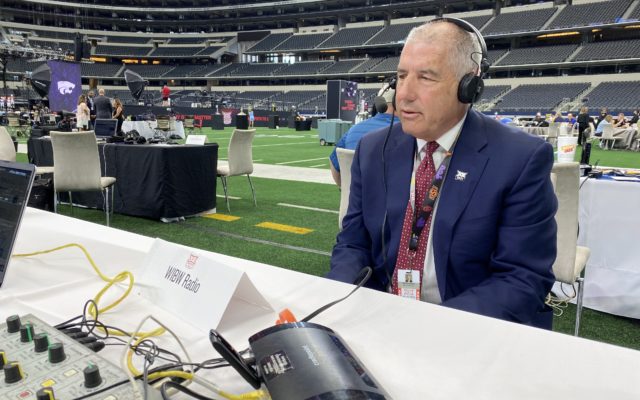Dzwierzynski: It didn’t have to be like this for the Big 12

Everyone who knows anything about college sports has known for some time that between now and 2025, the NCAA is at high risk of a chaotic storm of realignment ripping through the landscape. It’s been a talking point and a concern for the whole college athletics ecosystem since the last major wave of realignment.
Don’t tell the Big 12 that, though.
The heartland’s Power 5 conference would rather stew in its own blissful ignorance, letting the world pass by and make money moves while it sits idly by and misses the proverbial boat again.
And again. And again.
It isn’t 2025 quite yet, but that storm is coming and the Big 12 isn’t ready for it. Oklahoma and Texas reportedly want out and are planning to speak to the SEC in the immediate future about joining that conference. There are plenty of reasons to ponder and critique this choice of direction by the Big 12’s premier brand and Texas, but there’s also some obvious motivation behind it. Why would two programs like that want to linger around an albatross of a conference that doesn’t care about making its own situation any better?
By now, it’s effectively the Big 12’s official position that it refuses to be proactive about anything. If there’s a chance to look ahead and prepare for the future, maybe even take action now to avoid impending doom, the Big 12 will simply refuse to take advantage of the situation. That’s been abundantly clear for years, and it’s only been reaffirmed recently.
A report out of Lubbock, Texas made it seem as though that era of the Big 12 was closing. The Lubbock Avalanche-Journal reported that the conference had reached out to its TV partners to discuss updating its contracts before their grant of rights expires in 2025 (there’s that pesky year again). That felt like an essential move and a welcome one, given the conference’s reluctance to ever think in its own best interest.
Never fear though, dear reader, the Big 12 was steadfast and refused to deviate from its sedentary and self-destructive roots.
At Big 12 Football Media Days last week, Big 12 commissioner Bob Bowlsby told 580 Sports Talk, in no uncertain terms, that he’s not concerned about the TV deals with such a long time to go before the G.O.R. expires.
Bowlsby addressed the conference makeup, too, assembling a textbook example of dramatic irony when he discussed the league being as close as ever.
While we’re playing the hits, let’s not forget about Bowlsby’s comments to the entire press corps at AT&T Stadium, when he also pushed back on the notion of the conference realigning or expanding.
Perception is reality, so how do you see this situation? Did Bowlsby and the rest of the Big 12 know about OU and UT’s growing discontent and simply hide the reality at media days? Was he completely clueless that the two most important members of the league were planning to stage the closest thing to a walk out you can get in big-time college athletics? Is he just clueless in general?
Consider every factor and ask yourself one more question: How could any of this be perceived as encouraging?
This is a conference that has been battered by public perception for a decade now. There’s been a seemingly never-ending wave of “the Big 12 is dying” discourse since the last time conference realignment massacred the status quo. The Big 12 got it wrong then, so it’s only fitting that it’s getting it wrong now, too.
Removing Oklahoma and Texas from the Big 12 makes the conference far less appealing in nearly countless ways. OU has kept Big 12 football afloat for years, and despite all the reasons to rag on Texas, from the legitimate to the hilarious, it’s an integral part of the league as it stands. The Big 12’s cache without those two takes a monumental hit, and that could be underselling it.
But instead of getting a chance to control the narrative and try to save face to any degree, the Big 12 is now the permanent victim in a dunk tank with a long line of challengers with perfect accuracy. Everyone, from the schools to the media to the fans, get a chance to step up and embarrass the Big 12, which can only sit on the platform and be dropped into the water again in perpetuity while the peanut gallery (literally everyone else in the world) laughs and laughs. It also doesn’t help the Big 12 that the schools aren’t exactly denying their reported interest.
It would be sad if it wasn’t so predictable. Instead, it’s just pathetic.
Go be aggressive for once and try to make a difference for the better. Speak loudly and openly about ESPN and FOX not reworking your TV contracts like the Avalanche-Journal reported and make it seem like you’re trying, at least. Make major overtures at Arizona and Arizona State and try convincing them to jump ship from the also-flimsy Pac-12. Do anything differently and maybe you’re not facing down the barrel of a crimson and burnt orange gun.
It isn’t a guarantee that this now highly anticipated move goes through. There are a slew of reasons why it may not work. If just four current SEC members vote “no” then that will block any attempt to add the Sooners and Longhorns, and Texas A&M and Missouri likely aren’t dying to play Texas any time soon. And in its two previous expansion periods, the SEC has never added a team in a state that already has representation within the conference.
Nothing right now is guaranteeing that Oklahoma and Texas will leave the Big 12 for the SEC. The seeds are planted, though. The whole world now knows that the conference’s two most important members are ready to bail for greener pastures. Even if the SEC turns them away, that doesn’t change the overall impact of Wednesday’s revelation.
Whether it’s the SEC, the Pac-12, the Big Ten or anyone else courting the Red River Rivalry schools, everyone knows they’re malcontents among their Big 12 peers. It didn’t have to be this way. The Big 12 didn’t have to become a punching bag for all comers, even its own members.
But, in entirely predictable fashion, it is. Now the futures of Kansas, Kansas State, Iowa State, Oklahoma State, etc. all come into question, if not doubt. How can you stand idly by while eight of the 10 teams in the conference are flung into uncertainty like that?
Bob Bowlsby isn’t the only one who deserves blame here. No one party is entirely to blame. It’s a collective problem, and now the collective is in dire straights. Instead of looking out for the membership’s best interests, the Big 12 sat on the sidelines yet again. It was gruesome enough the first time around; this time, it could be downright fatal.
And it could have been completely avoided.



